Over the past 14 years I have been fortunate to work with some of the finest building science organizations. As a student of building science I’ve been able to design and develop several multi-functional insulation technologies – proven to show sustainability and efficiency advantages versus conventional insulation products. These designs are based on two simple thermodynamics(1) (physics) principles:
1) Areas of high moisture flow to areas of low moisture(2). (Wet to dry)
2) Areas of high temperature migrate to low temperature. (Hot to cold)
The objective of this paper is to highlight the challenges in building construction related to moisture management and the negative impact moisture has on the building envelope – and to provide simple and easy to understand explanations to complex and convoluted building science terminology and concepts. The final portion of this paper lays out a simple “at home physics test” – you can do it yourself. Or, you can simply watch the video and see the results of our testing. Either way, you will witness the effects of thermodynamics (physics) in action. I hope you enjoy reading this paper as much as my colleagues and I have enjoyed writing it. For the purpose of this paper, roofs and walls are one in the same.
“The same approaches can be applied to both roofs and walls. The argument being that similar loads and the same laws of Physics apply.” – BSI – 090: Joseph Hayden Does The Perfect Wall, Building Science Corporation.
In order to create effective and sustainable insulation solutions – we need to let physics drive the design.
What Really is R-value?
The R-value standard was developed over 75 years ago by Everett Schuman, Director of Penn State’s Housing and Research Institute. The purpose was to provide professionals and building owners a simple and repeatable comparison method when evaluating an insulation material’s resistance to heat flow. When it was created, R-value was the only useful tool in evaluating the thermal performance of building insulations. Much has changed in the last 75 years. Today, designers, engineers, code officials and savvy building owners know better than to focus on just a material’s R-value. The fact is; R-value by itself can be dismissed as a relatively meaningless number. To understand a conventional insulation material’s R-value, we can use the analogy of a polar bear’s fur. It is not the fur itself that keeps the bear warm, but rather the dead or “quiet” air trapped between the strands of hair that insulates the bear. Just like the bear’s fur; most conventional insulation products trap air within a fibrous or polymer cellular matrix. When the cells get compressed, are breached by fasteners and framing (thermal and point bridges) or become damp, the product’s R-value is compromised.
R-value – Laboratory vs. Real World
When questioning whether R-values should be used to compare insulation systems, the US Department of Energy, Oak Ridge National Laboratory (ORNL) states the following:
“R-values are a good starting point – but they are the results of small, meticulously prepared laboratory samples and do not necessarily reveal how an insulation system performs once installed in actual buildings. Different insulation systems with the same laboratory R-value can deliver much different levels of comfort and energy efficiency.”
ORNL is correct. Laboratory results based on an insulation material’s R-value doesn’t necessarily reflect how it will perform in different assemblies and under variable environmental conditions. Zero wind, zero moisture, zero solar radiation and meticulously installed insulation is not the real-world. Buildings leak air, vapour, water and heat. There is solar heat gain, water vapor and rain from the atmosphere. Occupants within the building are showering, cooking and breathing. Inside buildings, moisture moves inward and outward – up and down, through walls, roofs and ceilings. The point being; there are a lot of variables related to insulation that laboratory testing does not consider.
Moisture/water naturally takes the path of least resistance. For example, consider what happens if we pour water on a paper towel, wool fabric and plywood. Due to its low resistance to moisture, the paper towel soaks up the water immediately. The wool fabric will easily absorb water but at a slower rate than the paper towel. Plywood on the other hand, has high resistance to moisture and tends to repel, rather than absorb or adsorb. When exposed to air, water that sits on a plywood surface will quickly drain or evaporate
Through the diffusion(3) process, fiber insulation easily adsorbs moisture. Reciprocally it will give off moisture (dry) easily. Just like the paper towel. Fiber insulation gets wet fast but it also drys fast. When an insulation product readily adsorbs moisture, it will readily give off moisture. Rigid foam and spray foam are slower to adsorb moisture – hence, they are slower to give off moisture (dry).
Effects of Moisture on R-value
Small amounts of moisture cause a dramatic drop in R-value – often by as much as 50 percent or more. According to Steven Badger, Ph.D., water’s thermal conductivity is nearly 20 times higher than the conductivity of the average thermal insulation. Professional Service Industries Inc., a division of construction materials testing firm Intertek states:
“Absorption of only 20 percent moisture can cause up to 55 percent loss of insulation value. As a result, to ensure that insulation does its job, it’s crucial to consider moisture performance when selecting insulation – especially in high moisture exposure applications.” – Intertek PSI, Building Envelope Documented Causes and Effect of Unintended Moisture Intrusion June 1st, 2015.
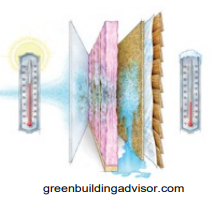
The preceding paragraph is really important. When insulation takes on water vapour; the pockets of R-value enhancing quiet dry air are replaced with R-value destroying moisture. When the temperature within the insulation decreases, the adsorbed water vapour often phase changes and turns to liquid water (condensation). This is referred to as the dew point(4).
The Ongoing Moisture Battle
When heating a building, the high temperature/high moisture indoor environment wants to blend with the low temperature, low moisture outdoor environment. Basically, they want to become one in the same – achieve equilibrium(5).
When cooling a building, the opposite occurs. The high temperature, high moisture outdoor environment wants indoors. There is a constant battle of moisture moving in and out of the building envelope. Air conditioning adds insult to injury. But, since we like comfort more than we dislike the negative consequences of moisture; comfort takes precedence. We can have both – we simply need to conform with; rather than challenge the laws of physics. Over the long term; physics always wins.
“It ain’t what you don’t know that gets you into trouble. It’s what you know for sure that just ain’t so.” – Mark Twain
When it comes to insulation there is no “one shoe fits all” perfect product. An insulation product that performs well in one application, is often I neffective in a different application. For example, fiber insulation is ideal for attics and cavity walls. Its fast, reasonably effective and low cost – but due to high moisture adsorption and low compressive strength, it’s totally ineffective in below grade applications. Rigid foam is ideal for roofs, walls and below grade applications but because of its rigidity, it doesn’t easily fill in voids. As a consequence, rigid foam is a poor choice for ceiling and wall cavities. Spray foam is typically vapour semi-permeable, extremely versatile and light weight. It is ideal for filling cavities, cracks and voids.
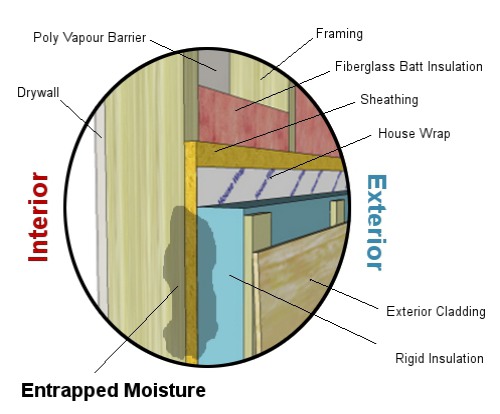
“Both high and low-permeance exterior insulation can improve energy efficiency and durability. At the same time, each must be used appropriately to avoid moisture-related issues such as mold. For high-permeance insulation (i.e., mineral wool), the main concern is inward vapor drive; for low-permeance insulation (e.g., XPS, foil-faced polyiso), the concern is trapping water against sheathing.” – RDH Building Science Laboratories
Absorption vs. Adsorption
Most insulation manufacturers claim their products do not absorb moisture. Technically that’s an accurate statement, but it’s misleading. It gives the impression the insulation product won’t get wet. All conventional insulation products have the ability to adsorb moisture. Knowing the difference between absorb and adsorb is important. Both are sorption(6) processes.
- Absorption occurs when a fluid is dissolved by a liquid or solid – e.g. a paper towel soaking up water or creamer blending with coffee. When solid materials dry out, they often change shape, color and lose some of their structural integrity. – e.g. paper, cardboard.
- Adsorption is the process where moisture clings to a surface (no soaking in or blending effect) – e.g. condensation on a glass of ice water, or vapour clinging to the exterior surface and/or the interior matrix of fiber or foam insulation. When they dry out; products that adsorb moisture, typically retain their original shape and performance characteristics. – e.g. most wood products, rigid foam, concrete.
Permeance vs. Permeability
An ongoing misunderstanding exists as to how water vapor moves through semi-permeable rigid foam insulation. Most people believe that because rigid foam is semi-permeable as its thickness increases, its permeability decreases. As a result, they think thick semi-permeable rigid foam will act like a vapour barrier. It doesn’t. Hopefully the following explanation clarifies this misconception.
- Water vapour permeance is a performance evaluation, or measure of the water vapour transmission rate through a material over a period of time. Think of permeance as the Gate-Keeper. Permeance describes the ease with which vapor molecules can diffuse(7) (get through) a specific material. The thickness of the material is most often irrelevant. Product’s such as polyethylene, foil and glass are considered impermeable; which means they are effectively perfect at blocking moisture – regardless of their thickness.
- Permeability is a material property that does not change with thickness. Permeability is the ability of water vapour to transmit from one side of an insulation slab to the other. Permeability is a dynamic or movement process. As long as there is some form of pressure(8), water vapour will move. Making the insulation thicker doesn’t make it any less permeable – it simply increases the distance and time the water vapor has to travel. Closed-cell Expanded Polystyrene (EPS) is vapour semi-permeable – which means it will adsorb (take on) water vapour from it’s ambient environment and pass it on. Fiber insulation is vapor permeable. Fiber does what EPS does; the difference being; vapour moves faster and easier through fiber insulation than it does EPS.
“While EPS is a closed cell foam (slow water vapor and air transmission through the cell walls), the gaps between the cells will still allow for moisture to pass through the matrix.” – GM-0702: Guide to Insulating Sheathing, Building Science Corporation.
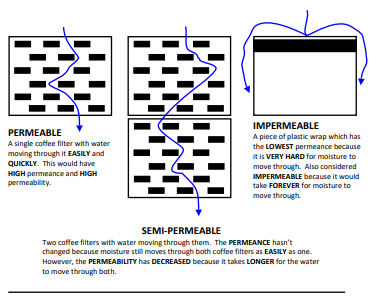
Analogy: Imagine three coffee pots. The first pot has one coffee filter. The second pot has two filters and the third has plastic food wrap. Because the plastic wrap is impermeable, no coffee makes it into the pot. The pot with one filter allow’s the coffee to easily and quickly fill the pot. Two filter’s are twice as thick as one. The distance the coffee has to travel through two filters, doubles; therefore it takes longer to fill the pot. When completed, the two filter pot will end up with virtually the same amount of coffee as the one filter pot. It takes more time for vapour to flow through a slab of semipermeable foam insulation than it does fiber insulation but regardless of it’s thickness, the vapour eventually gets through. When environmental conditions change; as they frequently do, water vapour can actually reverse course. It is constantly on the move – in, out, up and down. Vapour moves predominately outward in the winter and inward in the summer. It’s rarely static.
Buildings Get Wet and Often Stay Wet
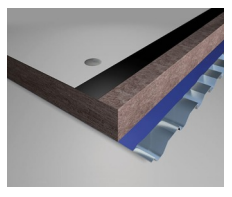
As a result of construction moisture, buildings often start off wet. Regardless whether the building starts wet or dry, insulation is typically connected to, and/or sandwiched between framing members, poly, substrates and cladding materials. Within the assembly, the building materials are touching or pressed against one another. As a consequence, there is minimal air circulation to help with drying.
Sooner or later the negative effects of thermodynamics (physics) kicks in – and moisture is created. Thermal bridging, diffusion and air leakage magnifies the process. Moisture is often trapped in-place with nowhere to go. The assembly gets inherently damp or wet, and it’s R-value is dramatically reduced. The potential for mold and material degradation increases. Nothing good happens! Analogy: Have you ever forgotten your sweaty clothing and a damp towel in a closed sports bag for an extended period of time?
The idea that it’s ok for an insulation product to take on excessive amounts of moisture; based on the assumption it will dry out later, is absurd. What’s the point of insulation if it loses 50% of its R-value while its damp, and its damp or wet 1/2 of the time? This is not an exaggeration – it’s reality for many flat and low slope roof assemblies.
“After moisture gets into roofing membranes and insulation, it is, in general, difficult to dissipate. […] Excessive moisture accumulated during cold weather normally will remain in the insulation or membrane until warmer weather and even then drying is not assured.” – Effects of Moisture in Built-Up Roofing, US Department of Commerce.
To avoid material deterioration and mold; best building practices recommend keeping the occurrence of moisture rare, accumulated quantities of water small, and drying sufficiently rapid. To see the significance of the above statement, check out the physics experiment below.
How warm would you feel in your wool jacket, if it were soaking wet?
There is a simple and low cost drying solution. To remain effectively dry, insulation systems need to incorporate multiple layers. The layers should be permeable but at the same time moisture resistant. To resist heat flow, an insulation system requires at least one thermal layer – two is better. To support continual drying, each layer needs to be separated by small air gaps. Think outdoor sporting garments.
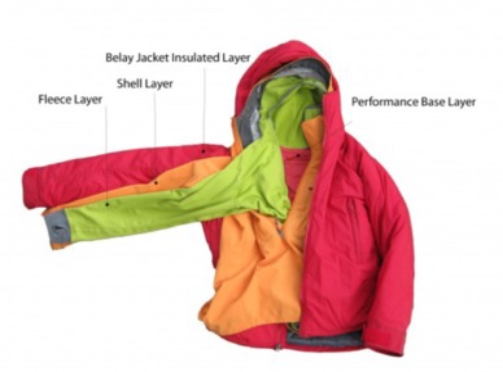
Now you might be asking these questions about the small air gap. How does the gap affect the thermal performance of the assembly; – and does a small 1/8” (2 or 3 millimeter) air gap really have a positive affect on the drying and draining ability of insulated assemblies? Joe Lstiburek PhD, P.Eng. answers those questions.
“But won’t the tiny gap cause a loss of thermal performance of the foam sheathing? Yes. How much? About 5 percent of the thermal performance of the foam sheathing (not the entire wall assembly) with the 1/8-inch gap, less with a smaller gap. … Is it worth it? Yes, in my opinion, the loss in thermal performance is trivial compared to the reduced risk and improved durability. The 5 percent thermal loss is also easily offset by the improved thermal performance of the closed cell high-density foam insulation. Even if you think you are perfect with a water control membrane, go with a gap. The air-gap is simple, elegant and unbelievably effective in helping out drying.”
– Joe Lstiburek PhD, P.Eng., Building Science Corporation – BSI-038: Mind the Gap, Eh!
Full scale Effective R-value testing, (ASTM C1363) and subsequent Hygrothermal(9) Analysis’s confirmed the predicted loss of thermal performance is negligible at best.
RDH Building Science Laboratories states:
“The excellent drainage performance and improvement in drying within the vented cavity under small (~2Pa) wind pressures of the wall assembly constructed with SDI reduces moisture durability risks of the enclosure that could result from water getting trapped and held between the components of the wall assembly.”
– Evaluation of Solar Dry Drainage and Drying Testing. RDH Building Science Laboratories. Report No.:12682.000
Steven Doggett, PhD. LEED AP states:
“Natural convection within the open drainage channels did not significantly affect moisture or thermal performance. While the open channels enhanced vapor release, diffusion occurred primarily through the perforated insulation system.” “The predicted reduction in thermal efficiency was less than 1%.”
– Moisture Performance Report, Built Environments, Solar Dry Insulation on Wood Frame Construction, Report No.: 012019-2
Scientists consider physics the “model” scientific field. Physics possesses a well-tested collection of defining theory, abandonment of theories that don’t survive reality-testing and a high degree of intellectual honesty.
Definitions:
(1) Thermodynamics deals with the transfer of heat energy from one place to another and from one form to another.
(2) Moisture: Water in a small quantity as vapor, within a solid, or condensed on a surface.
(3) Water Vapour Diffusion: The process by which water vapor spreads or moves through permeable materials caused by differences in water vapor pressure.
(4) Dew Point: The temperature to which air must be cooled to become saturated with water vapor. When air cools to its dew point through contact with a
surface that is colder than the air, water will condense on the surface.
(5) Equilibrium: A condition in which all acting influences are canceled by others, resulting in a stable, balanced, or unchanging system.
(6) Sorption: The ability to capture moisture.
(7) Diffusion: The movement of water vapour molecules through a material.
(8) Pressure differential: The difference in pressure between the inside and outside of the building.
(9) Hygrothermal pertains to the movement of heat and moisture through buildings. Computer-based modeling offers highly accurate predictions of hygrothermal performance for preventing early degradation and reduced service life. built-environments.com
A Simple Physics Test You Can Do
The following table top test method is something anybody can do. There are no manmade influences. No mechanical or infrared heating or artificial cooling or high tech environmental chambers and most importantly – no bias conclusions. Your readings and weights may vary from ours, but the observations will be unambiguous. The methodology is sound.
To validate results, repeat the test. The test method compares the drying ability of fibrous mineral wool insulation (vapour permeable) vs. film/foil faced (impermeable) rigid foam vs. perforated film/foil faced (semipermeable) rigid foam with a small air gap – in simulated miniature flat or low slope roof-like assemblies. Also read about our self drying roofs.
About the Author:
Ted Cullen is President at Quik-Therm Insulation Solutions. Over the past 10 years he has designed and developed several multi-functional innovative insulation technologies. Cullen has applied for and been granted 3 utility patents. 2 other insulation technologies are currently in the “patent pending” stage. One proprietary invention; a unique pressurized propulsion technology has been successfully manufactured and marketed for over two decades. Ted can be reached at ted@quiktherm.com
